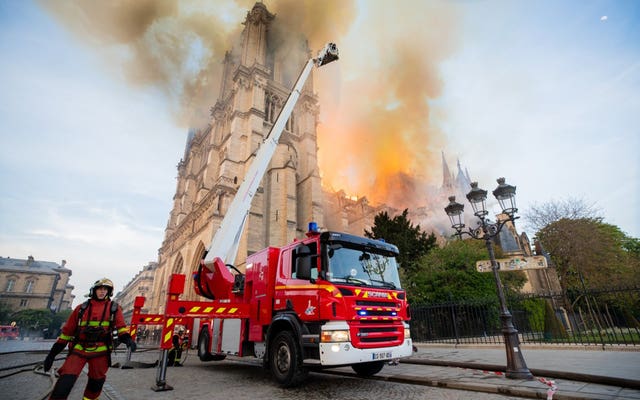
Melted scaffolding on top of the fire-ravaged Notre Dame Cathedral will be removed “in the coming weeks” to allow restoration work to begin next year, France’s culture minister has said.
It has been six months since an April 15 fire gutted the medieval Paris structure, which was under renovation at the time and criss-crossed with scaffolding where its spire once stood.
The twisted metal remained in place after the fire as engineers tried to determine whether removing it would exacerbate structural weaknesses from the blaze.
French culture minister Franck Riester said that before rebuilding can begin, several more months of conservation work done in parallel with an evaluation of the cathedral’s soundness need to be completed.
“Our Notre Dame de Paris is not yet totally saved,” Mr Riester told reporters.
President Emmanuel Macron promised in April that France’s beloved landmark would be restored within five years.
Critics say his timeline is overly ambitious.
The culture minister offered few hard deadlines.
He told reporters that the French government prioritises quality over speed, though he said the five-year time frame represents the state’s “ambition to mobilise”.

“For us, the top priority is to do a quality restoration that captures the height of what our history represents for our country, for Paris, for the Catholic religion, for Notre Dame,” Mr Riester said.
The government has not settled on a particular path for reconstruction.
Mr Riester promised wide consultation and debate.
As head of state, Mr Macron has the final word because the French government owns Notre Dame.

“We are determined to do things in a totally transparent manner,” Mr Riester said.
The budget for the project also remains undecided.
Some 350,000 donors have given or pledged a total of 922 million euros, according to Mr Riester.
The Notre Dame Foundation has received 104 million euros to date.
Mr Riester also addressed public criticism that French officials were slow to recognise the potential harmful effects of melted lead from the cathedral’s roof that drifted into the air and onto surfaces below.
He said health officials take regular samples from areas around Notre Dame to check for lead, and that workers on the site take appropriate precautions.
Authorities ran 877 lead tests on people in surrounding neighbourhoods at risk of exposure to lead pollution from the fire and only 10 showed dangerously elevated levels, Mr Riester said.


Comments: Our rules
We want our comments to be a lively and valuable part of our community - a place where readers can debate and engage with the most important local issues. The ability to comment on our stories is a privilege, not a right, however, and that privilege may be withdrawn if it is abused or misused.
Please report any comments that break our rules.
Read the rules here